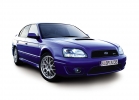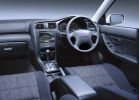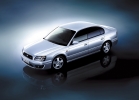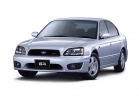Subaru Legacy 2002 test drive - 2003 sedan
Verified - no
 Reliable and hardy, endowed with all -wheel drive, Subaru cars seemed to be specially created for Russia. However, many treat them incredulously, considering it technically complex and expensive in content. How substantiated such fears are, we will find out by the example of the Legashi model/outback of the 1999 model.
Reliable and hardy, endowed with all -wheel drive, Subaru cars seemed to be specially created for Russia. However, many treat them incredulously, considering it technically complex and expensive in content. How substantiated such fears are, we will find out by the example of the Legashi model/outback of the 1999 model. Legasi is older than classmates
According to the boring modern automotive hierarchy, Legashi belongs to the so-called segment D (or middle class), where the Japanese models of the Nissan-Recimer and Toyota Avenues are among the leaders. However, Subaru is perceived more expensive and prestigious. Designers managed to make a car more adult size. This is especially true for Outbek. He looks worthy even against the backdrop of a Volvo-Cross-Cantry. Moreover, the solidity of Legasi is not only visual deception. The car has a spacious, noblely trimmed salon and very capacious (especially in the station wagon) trunk. And on the go, the car is very solid, comfortable. According to the sled sensations of Legasi, the middle class unequivocally outgrew.
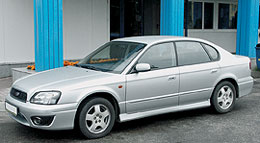 The station wagon is more popular than the sedan
The station wagon is more popular than the sedan Subaru's technical policy led to the fact that the station wagon has become much more popular than the sedan. After all, only station wagons with a manual gearbox, like all -terrain vehicles, have a drop -down series in the transmission and an anti -traffic system that allows you not to play gas and adhesion pedals, touching the mountain. Such abilities in the car are primarily appreciated by people who lead an active lifestyle those who carry a trailer with a jet ski or climbing snow porridge at a ski base. It is not surprising that it was on the basis of the station wagon that the version of the outbuke was created a cross between a passenger car and a parquet all -around. True, in America there is also a sedan outbuke, but it does not come to Europe or Russia.
Legashi does not know any problems related to the body and electrical equipment of the salon. For corrosion, if the car was not a bat, it's not the time yet. And an electrician, even on cars operating in salted Moscow, works flawlessly. By the way, door glass without frames, contrary to the fears of many, do not cause complaints do not flow and do not come into speed.

Outbek has an enlarged road clearance and a protective plastic belt along the lower body perimeter
Unique boxers
The gasoline engines installed on Legasi (as well as on Impreza) have an opposite cylinder arrangement. In fact, these are V-shaped motors with the angle of the collapse of the cylinders in 180. For such a configuration, they received a nickname of boxers (the pistons move horizontally, like a boxer’s fists). Such a layout allows you to ideally balance the engine and reduce the center of gravity. And fans of Subaru love boxers for their inimitable sound.
On Legasi, mainly 4-cylinder engines with a volume of 2.0 liters (125 l.) And 2.5 l (156 hp) are found. In the mid-2000, they were a 3-liter six with a capacity of 209 forces, combined exclusively with an automatic box. However, there are few cars with such a motor, they are initially roads, roads in customs cleaning and therefore, most likely, will not be imported into Russia.
It is believed that opposition engines are complex in design and road roads. As for the design, they are not complicated, but simply unusual for most mechanics. There are also no special troubles in maintenance. In the case of a large repair with the boring of cylinders, boxers will really require special equipment and special skills. But to bring to such a state any of the Legasi engines is difficult, they all established themselves as very reliable.
Real reproaches for the tendency to overheating were earned by a 2.5-liter motor, which was installed on the Legashi/Outbek of the past generation. But in today's model, the engine design has changed, and it completely got rid of the threat of overheating.
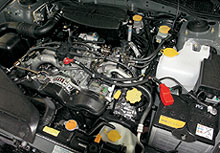 Engines in operation
Engines in operation The spark plugs on our gasoline can hardly withstand two intervals between TO (25,000 km). The cooling liquid must be changed after 50,000 km, and this order is better to adhere to. But checking the gaps in the valves after 100,000 km can be considered a formality. Experience shows that adjustment is almost never required.
The timing belt changes after 100,000 km. Moreover, together with the belt, it is advisable to change the crankshaft and camshafts, as well as a water pump. Practice shows that they will live a little longer, and if you do everything in the complex, you can save. In addition, when updating the timing belt, some of its rollers may require replacement, and the tensioning so for sure (when it fails, a clatter sound is heard when starting). If the rollers are changed simultaneously with the belt, pomp and seals, you will not have to pay extra for work. In the table, we indicated the cost of all four videos.
With a run of about 70,00080,000 km, it is advisable to rinse the idle valve. Over time, soot forms on it, and idle turns begin to swim. The main thing is to correctly install the valve after washing.
In Moscow, where every winter they are experimenting with new anti -headed reagents, cooling radiators periodically flow. Apparently, not with every chemistry they can get along peacefully. Therefore, it is advisable to wash the radiators in winter more often.
A 2.5 -liter engine can fail at the time of connecting the air conditioner, and even stall at idle. This is due to the quality of the fuel, and is treated with reprogramming of the injection computer in the corporate Subarovsk technical center.
It's all. There are no other problems for the engines of Legashi.
What is the price
Replacing candles $ 50
Replacing timing belt with pomp and $ 435
Rollers (4 pcs.) $ 168/61/61/57
Replacing the cooling radiator $ 430-480
Correct all -wheel drive
In Japan, Subaru is an unconditional leader in the field of passenger full -wheel drive. This is expressed in the design of the design and the correct transmission scheme. Why is it right? Yes, because it provides a constant transfer of traction to all four wheels. Not an automatic connection of the front or rear axle in the case of slipping the opposite, namely constant traction on all wheels. Thanks to this, stable and predicted behavior of the car in slippery turns is ensured.
With a manual gearbox, the distribution of the moment between the axes is 50:50. With an automatic ratio, it can change slightly towards the front or rear wheels, depending on the engine. But, we repeat once again, the car always remains all -wheel drive.
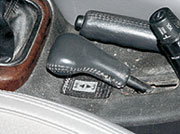
The pear -shaped handle next to the parking brake lever is in charge
True, not all Legasi are all -wheel drive. In the countries of Southern Europe and the Middle East, front -wheel drive versions are also sold, which are sometimes found in the secondary market. But is it worth buying Subaru if he is deprived of his main dignity?
There are no complaints about the reliability to the all -wheel drive transmission. The cardan gear is almost eternal, and the rear gear seals are extremely rare. In the rear bridge gearbox, the oil changes after 50,000 km. If a differential of high friction is installed in it, a special variety of oil is required.
 Universal in pneumatics
Universal in pneumatics Some station wagons (not outbacks) with a 2.5-liter engine instead of a spring are equipped with a pneumatic suspension. It does not allow the car to sag under load, and on a bad road can increase the road clearance to the level of outback. While the pneumatics are new, it works fine. But on our salt and dirt pneumoballons are enough for 70,00080,000 km, after which the car lies on the ground. The new pneumatic resistance costs about $ 600700, and they need four. It’s cheaper to buy a set of ordinary springs with shock absorbers on disassembly than spending on pneumatics. Therefore, if you need a station wagon, choose either an outbek or a regular machine on a spring suspension.
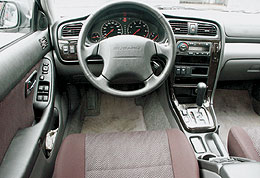 Mechanics or machine gun?
Mechanics or machine gun? The choice depends on what purposes the car is purchased. If this is an ordinary legashi, on which you are going to drive only on normal roads, you can choose a gearbox based on personal preferences.
If we are talking about outbuke, which periodically will have to turn off the asphalt, and even with a jet ski or snowmobile on the trailer, it makes sense to think about the mechanics. In mud, snow or loose sand, the reducing gear in the handout will increase traction on wheels and help save the clutch.
For an automatic box, the lowering box is not provided. In principle, a powerful 2.5-liter engine (2-liter on the outbuke is not placed) in loose soil copes with the automaton and without lowering. But in order to save the box, the presence of a lowering gear in such conditions is still desirable. True, cars with a machine gun can also have a trump card to combat off -road. On some outbacks with an automatic box (and only with it) there is a system of dynamic stabilization of VDC. It not only helps to avoid drifts, but also imitates the blocking of inter -coil differentials, improving cross -country ability.
The adhesion in the manual box serves an average of 80,000120,000 km. However, on cars with a 2.5-liter engine, it may have to be changed earlier for considerations of comfort. The fact is that this engine sets a clutch with a two -mass flywheel, which until recently could make crackling on neutral or screeching when recruiting speed in the region of 20,000 revolutions. To get rid of this, it is better to install a clutch with an ordinary flywheel from an old 2.5-liter engine. Together with work, this will cost $ 900. The manual box itself is quite reliable, and the oil in it is ordered to change after 50,000 km.
The automatic box on the current generation of Legashi began to work much softer, but remained as thoughtful as before. Two additional sports and winter modes have been preserved in it. Mechanics do not present any complaints about the reliability of the machine gun, with the exception of the human factor. The oil in it also changes after 50,000 km.
A hardy chassis
Subaru has long established themselves as hardy, and the present Legasi was no exception. The chassis of the car was very strong. We will not take the stabilizer racks. They are consumables on any car. In this case, the first interventions in the suspension are required only by approaching 100,000 km, when the time for replacement of shock absorbers comes. Moreover, for the first time, shock absorbers usually change without upper supports.
Most of the parts of the suspension and steering, as can be seen from the table, even on our roads withstand 150,000200,000 km. That is, if you buy a mileage of about 100,000 km in Europe and leave for three years on it, the replacement of most parts marked more than 150,000 km will probably be able to shift to the next owner.
Perhaps the only weak spot can be called front brake discs that withstand only two sets of pads and leave for about 60,000 km. But you can put up with this. Otherwise, there are no complaints about the brakes. The main thing with each replacement of the pads is cleaned and lubricated so that the calipers do not acidify from dirt.
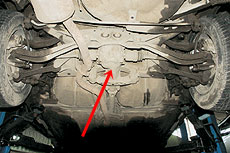
The hull of the rear gearbox (shown by the arrow) is vulnerable to off -road. It is better to put protection
Among the unscheduled expenses of mechanics, only a possible flow of the steering hydraulic power pump pump and, as usual, the replacement of the wheel bearings. The life of the latter depends on the number of potholes caught.
As you can see, on maintaining in good condition the Legashi chassis will not ruin you. There is only one really expensive position of the rear shock absorbers for outbuke, equipped with the function of automatic maintenance of road clearance depending on the load. For comfort, as you know, you have to pay.
Average service life of the chassis
Front suspension and steering
Rear suspension
30,000 - 40,000 km
30,000 - 40,000 km
stabilizer racks $ 95
Stabilizer racks $ 115
60,000 km
90 000 - 120,000 km
brake discs $ 280
Shock absorbers (sedan/outback) $ 655/1345
90 000 - 120,000 km
150,000 km
shock absorbers (sedan/outback) $ 500/645
Brake discs $ 250
upper supports of shock absorbers $ 120
more than 150,000 km
more than 150,000 km
silent blocks of longitudinal levers (2 pcs.) $ 90
balls $ 105
transverse levers (6 pcs.) $ 630
rear silent blocks of levers $ 195
Possible unscheduled expenses
levers assembly $ 410
replacement of the power steering pump $ 830
steering tips $ 160
Replacing the front hub bearing (1 pc.) $ 110
steering rods $ 165
Replacing the rear hub bearing (1 pc.) $ 185
_________________________________
Prices of original details, taking into account the replacement in the authorized technical center Subaru.
Buy?
So, the myth of the high cost of the content of Subaru scattered like a house of a house. In operation, Legasi costs no more than other Japanese, say, examples or gallants. And all its unique in technical terms (engine and transmission) require a specific approach only in case of unlikely major repairs.

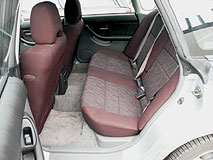
For its class, Legasi has a very spacious salon
Another thing is that Subaru is quite rare and therefore are worse provided by spare parts and a qualified service than Toyota, Nissan or Mitsubishi. Therefore, probably, it makes no sense to take Subaru in the regions, where there is completely no service base for them. But in large cities there are unauthorized Suerovsky workshops with moderate prices, and independent sellers of spare parts, from whom you can buy an original percent is 20 cheaper. And for clinical cases, there is a highly professional Moscow dealer Subaru.
Therefore, if you need a reliable and hardy car for all 365 days a year, Legashi or Outbek can be considered boldly. The most popular outbukes of 2000 from Europe from Europe cost $ 22,00024,000. The usual Legasi-2.5 for $ 10001500 is cheaper. The 2-liter engine (and, as a rule, a simpler equipment) reduces the price bar by two or three thousand. This is the situation in Europeans. Cars from America (especially outbukes) are about $ 2000-2500 cheaper. But if you put a European and an American nearby, you will understand that such a difference in price is quite justified by the quality of finishing materials and configuration.
Alexander Konov, photo of Alexander Sadovnikov
Source: Magazine "Limousine" [09/03]


